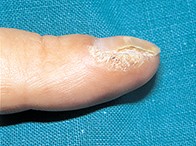Peer Reviewed
Feature Article Infectious diseases
Warts and all: a guide to diagnosis and treatment
Abstract
Warts affect about 10% of the general population. A very large number will eventually regress spontaneously; nevertheless, patients (or parents) will often be impatient for a quick cure. Care should be taken to ensure the patient has realistic expectations of the range of therapies available.
Key Points
- The incidence of warts in the general population has been estimated at 10%.
- Transmission of HPV can occur through physical contact or desquamated keratinocytes (e.g. on shower floors).
- Spontaneous regression or resolution occurs in a large number of warts. The average lifespan of cutaneous warts ranges from three months to three years. However, warts may multiply, extend or persist much longer. Rarely, warts can develop into squamous cell carcinomas.
- The differential diagnosis includes seborrhoeic keratoses, (‘warty’) solar keratoses, keratoacanthomas, squamous cell carcinomas, corns and callosities, lichen planus and, occasionally, molluscum contagiosum.
- The mainstay of treatment still consists of no treatment, topical preparations (e.g. lactic acid and salicylic acid preparations) and/or liquid nitrogen. Probably 99% of warts can be eradicated by using one or a combination of these methods.
Purchase the PDF version of this article
Already a subscriber? Login here.

